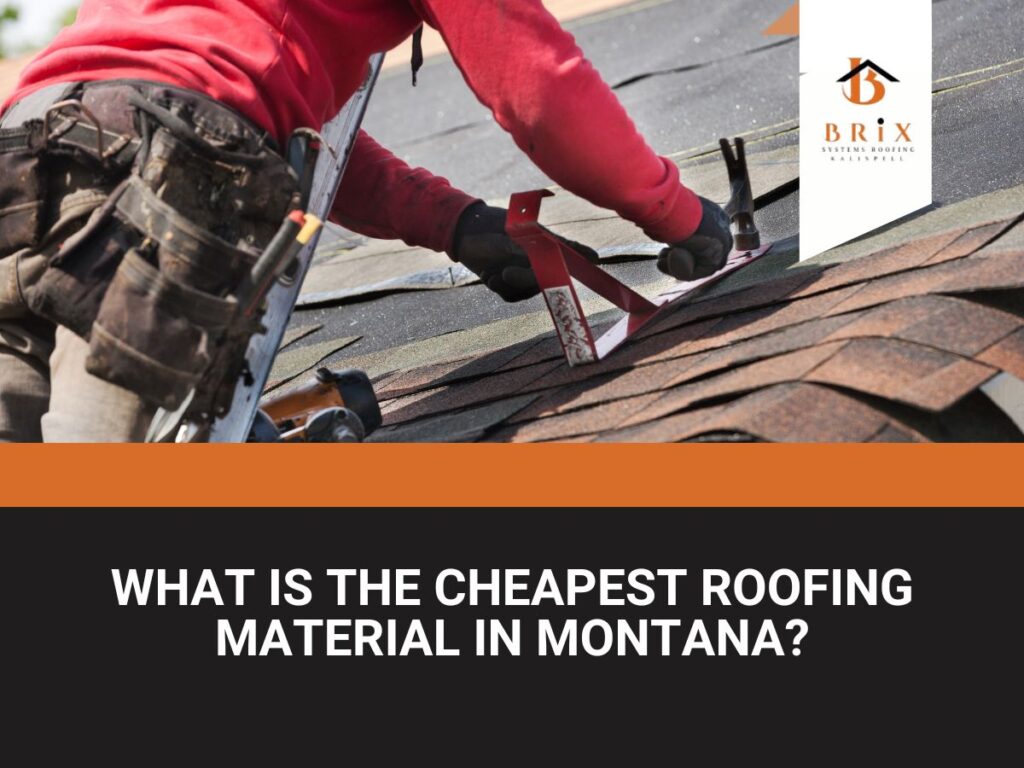
In Montana, selecting the most cost-effective roofing material is crucial for homeowners looking to balance budget and durability. The cheapest options typically include asphalt shingles, rolled roofing, and metal roofing.
Asphalt shingles, particularly 3-tab varieties, are widely recognized for their affordability and ease of installation. Understanding the various materials available can help homeowners make informed decisions that align with their financial constraints while ensuring adequate protection against the state's diverse weather conditions.
Choosing the right roofing material is crucial for balancing cost, durability, and style. Affordable roofing options like asphalt shingles, metal roofing, and rolled roofing offer cost-effective solutions without compromising quality. This guide explores these materials, helping you find the best option for your home and budget.
Asphalt shingles are one of the most common and budget-friendly roofing materials in the market. They are widely used in residential roofing because of their affordability and ease of installation. Asphalt shingles typically come in two varieties: three-tab shingles and architectural shingles. Three-tab shingles are the cheaper option, costing between $1 to $3 per square foot for materials alone and around $5,000 to $8,000 for an average-sized roof. Architectural shingles, which offer better durability and a more layered, stylish look, cost slightly more at $4 to $6 per square foot, with total installation ranging from $7,000 to $12,000.
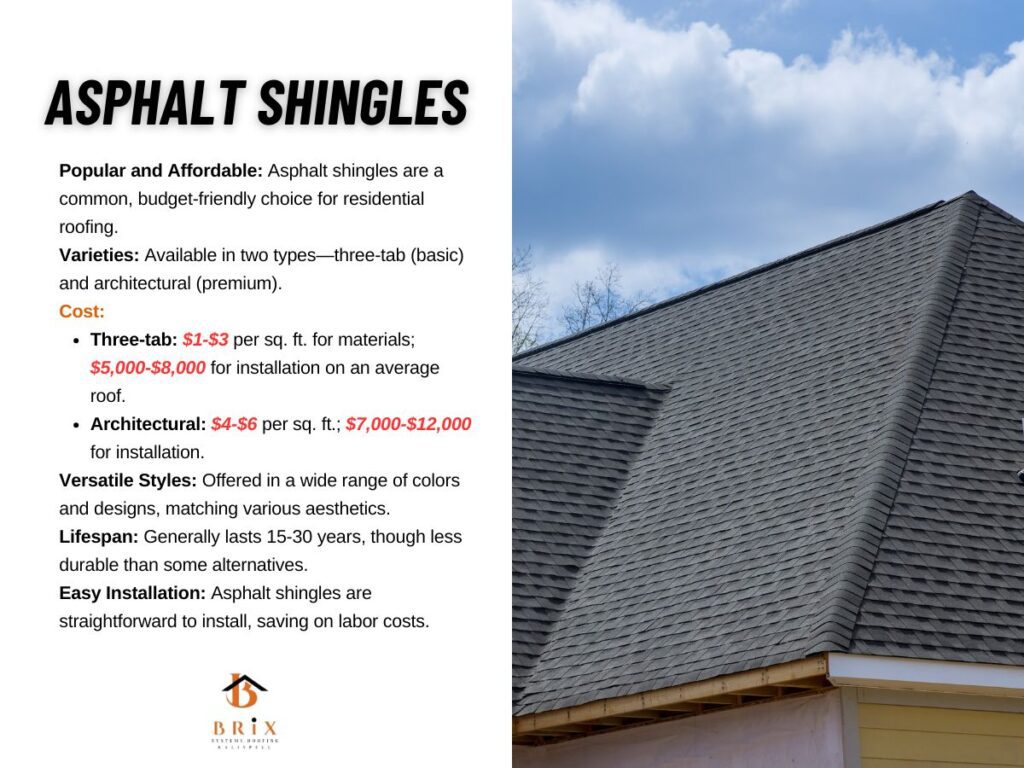
One of the biggest benefits of asphalt shingles is their versatility and availability in various colors and styles, which can suit almost any home aesthetic. While they may not last as long as some other materials, asphalt shingles usually offer 15 to 30 years of reliable performance.
Metal roofing is an increasingly popular choice among homeowners seeking a balance between affordability and durability. Although the initial cost is higher than asphalt shingles, the longevity and energy efficiency of metal roofs make them a cost-effective option in the long run. Metal roofing materials typically cost between $6 to $12 per square foot, and full installation can range from $9,000 to $14,000 for an average-sized roof.
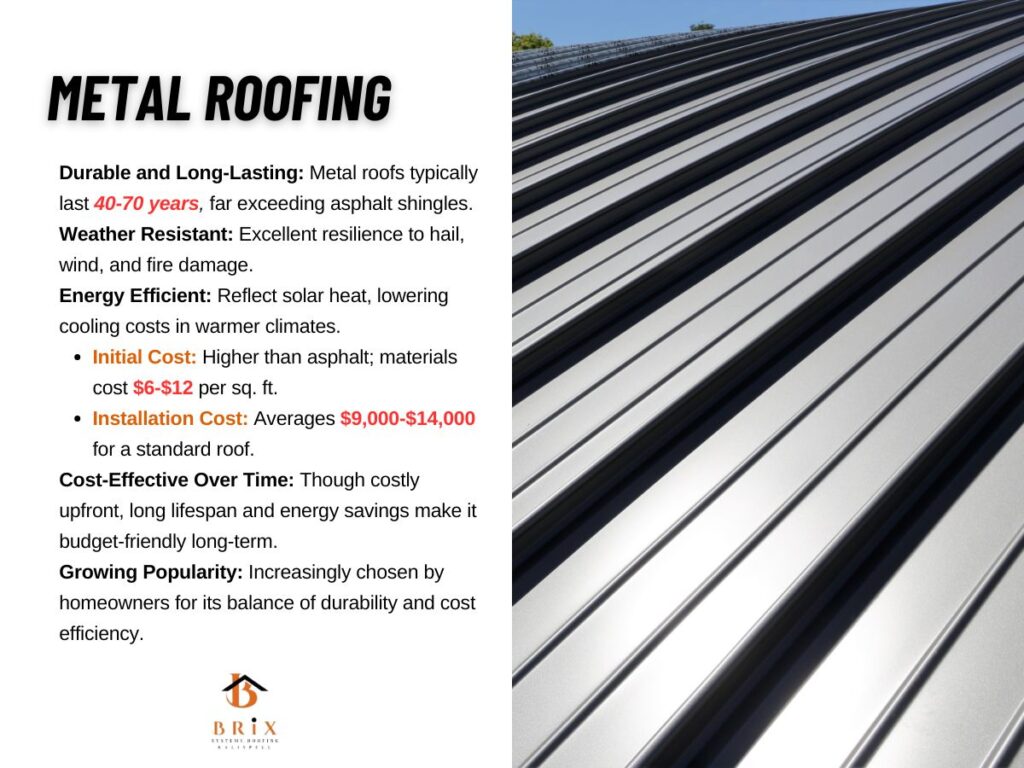
Metal roofs have a significantly longer lifespan, often lasting between 40 to 70 years, and are highly resistant to extreme weather conditions, including hail, wind, and fire. They also offer energy savings by reflecting solar heat, helping to reduce cooling costs in warm climates.
Rolled roofing is one of the cheapest roofing options, generally used for low-slope residential roofs or sheds. It is a mineral-surfaced roofing material that comes in large rolls. Rolled roofing is priced between $1.50 to $3 per square foot, making it a budget-friendly solution, especially for smaller projects. Total installation costs typically range from $2,000 to $5,000.
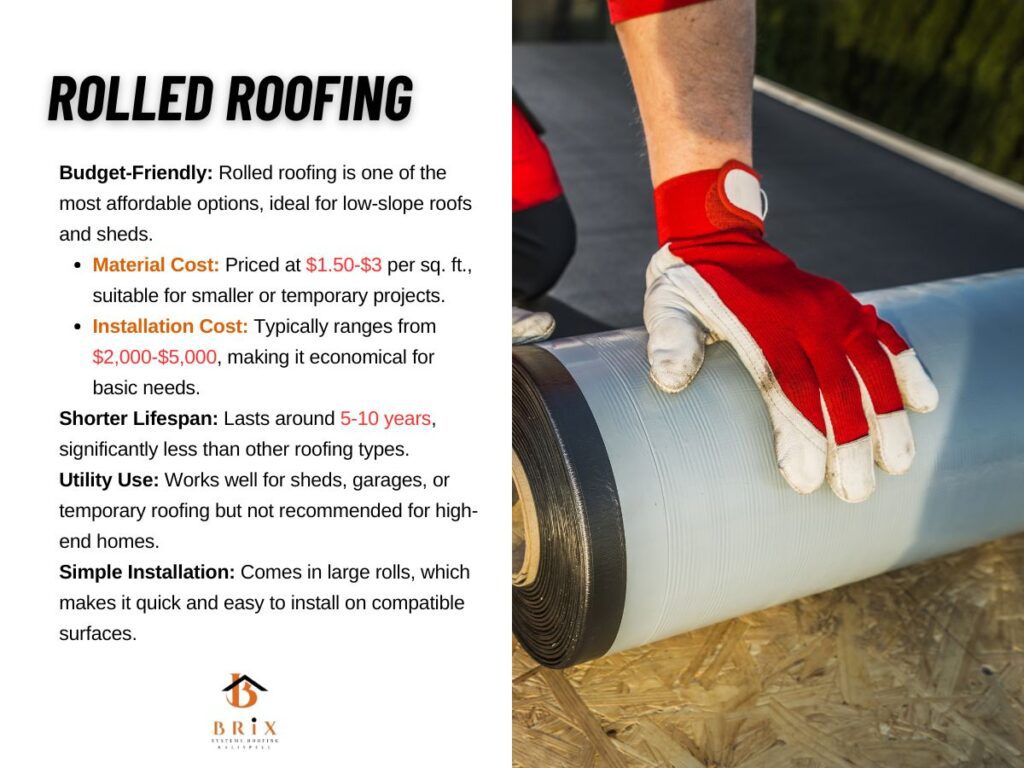
While rolled roofing is inexpensive, its lifespan is shorter, usually lasting around 5 to 10 years. It’s not recommended for high-end homes but works well for temporary or utility roofing needs.
Rubber roofing, commonly made from EPDM (ethylene propylene diene monomer), is an excellent choice for flat or low-slope roofs. This material is highly durable and offers exceptional weather resistance, making it a popular option for commercial buildings and homes with flat roofs. EPDM rubber roofing is known for its ability to withstand extreme temperatures, UV radiation, and moisture, providing long-lasting protection against harsh weather conditions.
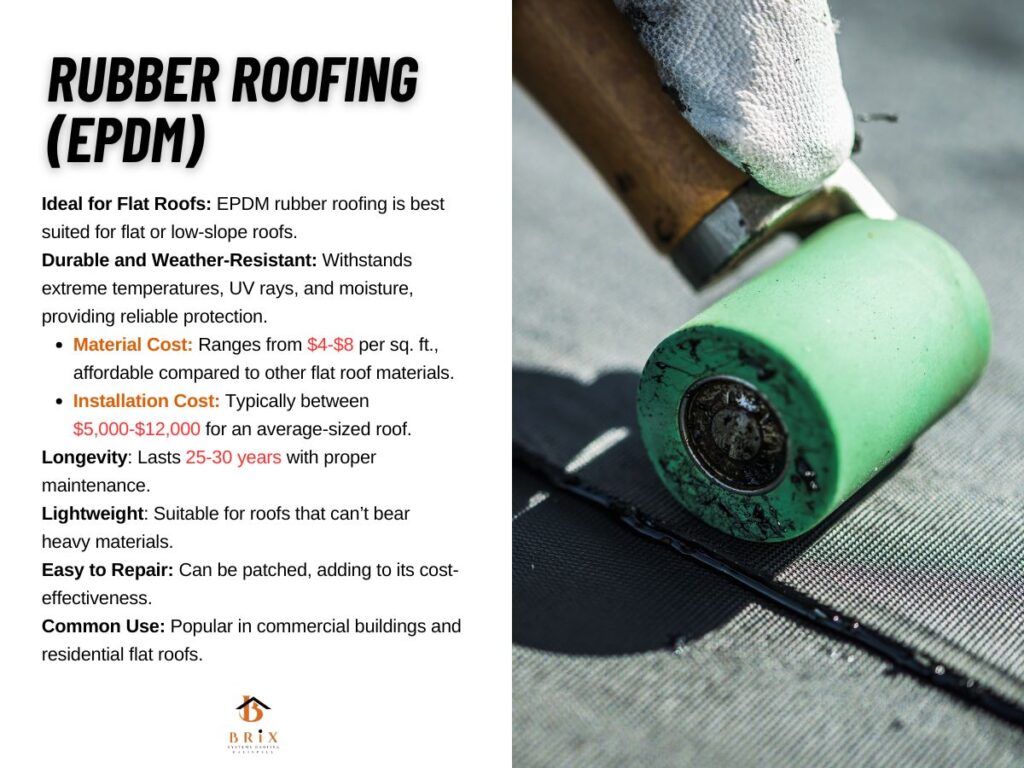
One of the main advantages of EPDM roofing is its affordability. The material typically costs between $4 to $8 per square foot, and installation costs can range from $5,000 to $12,000 for an average-sized roof. It’s relatively easy to install and maintain, and with proper care, EPDM rubber roofing can last for 25 to 30 years. The rubber membrane is lightweight, making it suitable for roofs that may not be able to support heavier materials. Its ability to be patched or repaired easily also adds to its cost-effectiveness over time.
Composite shingles are an innovative roofing material made from a mix of recycled materials like plastic, rubber, and wood fibers. These shingles are designed to mimic the appearance of traditional roofing materials, such as slate, wood shake, or clay tiles, but at a fraction of the cost. This makes them an attractive option for homeowners looking to achieve a premium look without the premium price.
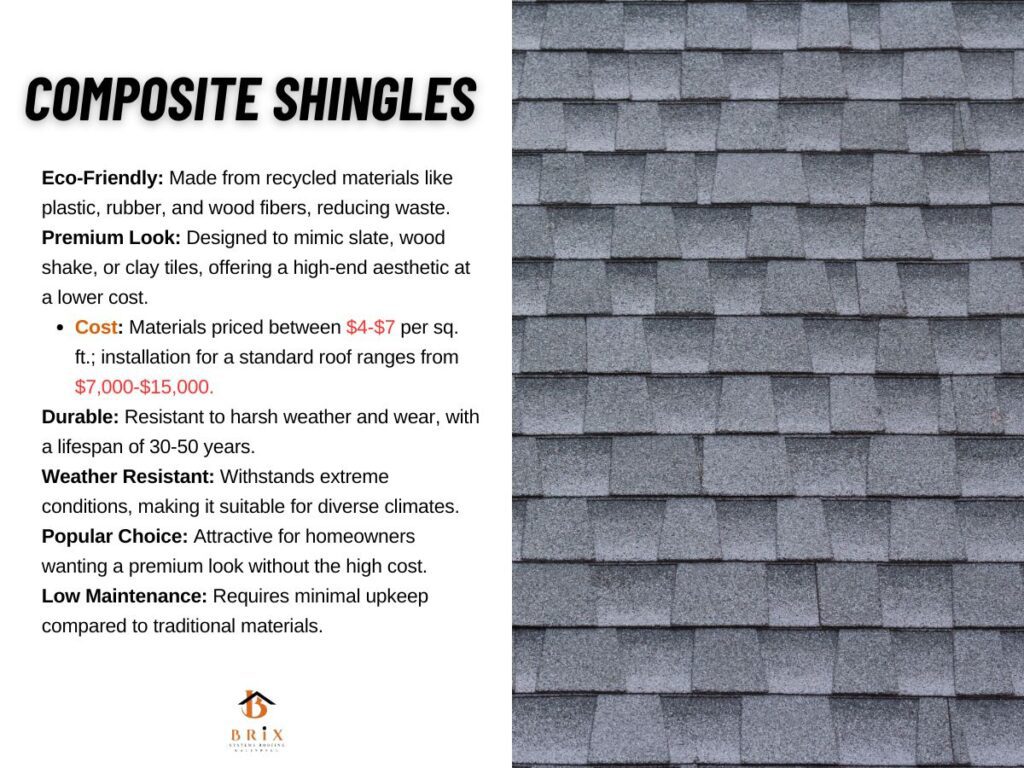
Composite shingles are priced between $4 to $7 per square foot, with full installation typically ranging from $7,000 to $15,000 for a standard-sized roof. They offer several advantages, including durability, resistance to harsh weather conditions, and a lifespan of around 30 to 50 years. Since they are made from recycled materials, composite shingles are an eco-friendly roofing solution that helps reduce waste while maintaining the aesthetics of high-end roofing.
Several factors influence the overall cost of roofing, ranging from material choices to the complexity of installation. Understanding these key factors can help homeowners budget effectively and make informed decisions when selecting the right roofing solution.
The type of roofing material is one of the most significant factors affecting the overall cost. Affordable options like asphalt shingles and rolled roofing tend to be more budget-friendly, while materials like metal, slate, or tile come with higher price tags due to their durability and premium appearance.
Asphalt shingles typically cost between $1 to $3 per square foot, whereas metal roofing can range from $6 to $12 per square foot. Luxury materials like slate or clay tiles can cost up to $30 per square foot. Homeowners should balance material longevity with upfront costs to choose the best fit for their needs.
The size of your roof directly impacts the total cost, as larger roofs require more materials and labor. Roofing contractors often measure roofs in "squares," with one square equaling 100 square feet. The more squares required, the higher the cost. The pitch (or steepness) of your roof plays a role in pricing. Steeper roofs are more challenging to work on, often requiring specialized equipment or additional safety measures, which can increase labor costs.
Labor costs vary depending on the complexity of the job and the region you live in. Roofers may charge more for intricate designs, steep roofs, or homes with multiple levels. In addition, labor rates differ by geographic location. Urban areas or regions with a higher cost of living generally have higher labor rates than rural areas.
If your existing roof needs to be removed before installing a new one, the cost of removing and disposing of old roofing materials will add to your total. Roof removal typically costs between $1 to $5 per square foot, depending on the material and the complexity of the job. Heavy materials like slate or tile may require more labor to remove and therefore cost more to dispose of.
Most municipalities require permits for roofing projects, especially for replacements or major repairs. Permit fees vary based on location and the scope of the project, typically costing between $100 to $500. Inspections may also be required to ensure the roof is up to code, which can add to the overall expense.
Additional features, such as skylights, chimneys, or roof ventilation systems, can increase both material and labor costs. These features require custom installation, which adds time and complexity to the roofing project.
While asphalt shingles are often the most affordable roofing option in Montana, their performance in harsh climates warrants careful consideration. Transitioning to our next topic, we'll explore how asphalt shingles compare to composite shingles in terms of durability, insulation, and overall value.
Understanding these differences will empower homeowners to make informed choices that not only fit their budget but also withstand the challenges posed by Montana's extreme weather conditions. Stay tuned!